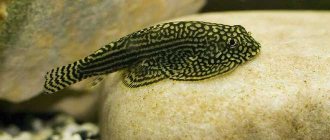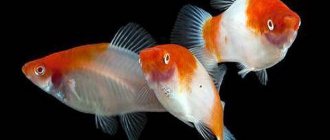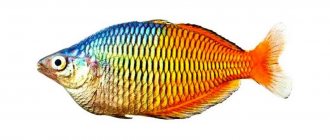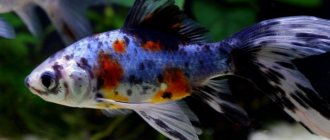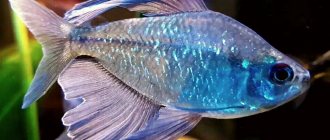author: fisher 01/21/2016 0 Comments
Family: Chain catfish
soms
Otocinclus affinis or common otocinclus is perhaps the smallest representative of the chain catfish family (Loricariidae). Even in nature, their size rarely exceeds 5 cm. Their habitat is limited to water bodies in the southeastern part of Brazil. Typical biotopes are shallow, slow-flowing rivers, lakes and ponds, with clear, clean water, densely overgrown with aquatic vegetation. In the Amazon basin, there are about 20 species of otocinclus, differing in size, color and pattern on the body. They are all suitable for keeping in an aquarium.
Otocinclus affinis
Otocinclus affinis is most often found in amateur aquariums. It has an elongated body, flattened on the abdominal side, covered with wide bony plates. The main body color is silver, with a slight yellowish tint. On the dark gray back there are light stains and small specks of brown. The abdomen is characterized by a yellowish tint. A wide dark stripe runs along the entire body. Transparent fins have a barely noticeable green tint. The eyes of Otocinclus are relatively large, and the mouth is a suction cup characteristic of the entire family.
In an aquarium, Otocinclus affinis reaches a size of 3–4 cm.
Sometimes they rise to the surface of the water and take a breath of air. This is normal behavior. Like most chain-mailed catfish, otocinclus have intestinal respiration, which allows them, with a deficiency of oxygen dissolved in water, to breathe atmospheric air.
Sexual dimorphism in the species is weakly expressed. But if you look closely, females can still be distinguished; they are somewhat larger and plumper than males.
Otocinclus spend most of their time on the wide leaves of plants, cleaning them from algae and microorganisms living on them.
Despite its modest size, this fish, hardly noticeable in the aquarium, is, along with the Siamese algae eater, one of the most effective algae eaters.
Otocinclus affinis is the most common inhabitant in all types of planted aquariums. This species is highly recommended for keeping in natural aquariums by Takashi Amano. They are much more mobile than ancistrus and, unlike them, they clean not only hard surfaces, but also plant leaves from algae.
Compared to other species, otocinclus more effectively fight algal growth, and they do this almost around the clock, without damaging even the most delicate plant leaves. Due to this feature and small size, many aquarists prefer otocinclus over Siamese algae eaters.
Otocinclus affinis cleans well the leaves of even such miniature plants as Echinodorus tenellus and Saggitaria subulata. Prevents and clears red algae from Anubias. In two days, a flock of otocinclus can completely clear an aquarium of brown diatoms (brown algae).
Description
Catfish eat brown, green and red algae, including blackbeard. Otocinclus belongs to the family of chain-mailed (loricariid) catfishes. Popular along with the Siamese algae eater. The range extends to Venezuela, Brazil and Argentina. Otocinclus affinis live in flocks, in which the number of individuals can reach several hundred.
Appearance
This catfish was named chainmail due to the presence of protective bone plates. The body is elongated, slightly flattened on the sides. Reaches 3–5.5 cm in length. The back is dark, the plates are yellow-gray, and the belly is white. There are longitudinal dark stripes on the sides. The dorsal and pectoral fins are sharp and transparent. Mouth with suction cup, large eyes. There are differences in color between species.
Behavior
By nature, catfish are peaceful and shy. They are most active in the evening, but you can catch them cleaning glass and stones at any time. They are hardworking and quickly clear the aquarium of algae.
How long does a catfish live?
With good care, otocinclus lives 5–6 years.
Kinds
There are more than 17 known varieties of Otocinclus, which are sold under a common name. All species are suitable for keeping in an aquarium. The most common types:
- Otocinclus affinis or common (Otocinclus affinis). The color is yellowish, with a brown stripe on the sides. There are brown spots on the dark back. The fins are translucent with a green tint.
- Mottled. The color is olive and yellow, there is a pattern of short stripes on the body, and black spots on the back.
- Arnoldi. The species, strongly reminiscent of Otocinclus vulgaris, is distinguished by dark brown spots.
- Maria. It is less common on sale. Suitable for keeping in small containers, as it grows about 2 cm.
Content
- 1 Description
- 2 Conditions of detention
- 3 Behavior
- 4 Food
- 5 Reproduction
Otocinclus vulgaris
- Other names: Otocinclus simplex, Otocinclus vulgaris, Oto, Common algae eater, Macrotocinclus affinis.
- Origin: tropical rivers and lakes of South America (Venezuela, Argentina, Peru, Brazil).
- Size: from 2 to 5 cm.
- Temperature: 22-28 °C °C.
- Water parameters: pH water hardness from 2 to 18 GH, acidity 7 pH.
- Lighting: bright.
- Behavior: peaceful, gregarious, hardworking.
- Additional information: occupy the lower, bottom level of the aquarium.
- Content difficulty: medium.
Quarantine before moving in
Before introducing them into the aquarium, place newly acquired fish in a quarantine container. Use a 30-liter aquarium without soil as a quarantine tank. If the disease is not detected within 3-4 weeks, place the otocinclus in a community aquarium. Water with a small peat content is suitable for quarantine. Add methylene blue solution for prevention. Do not add salt, solutions containing copper and insecticides to the water, as otocinclus does not tolerate these substances well.
View this post on Instagram
Posted by Moscow Aquarium Fish (@mosaquafish) Jan 16, 2019 at 2:41 PST
Aquarium
To maintain a group of 6 individuals, a 70 liter aquarium is sufficient. Select a rectangular-shaped container with a wide bottom. Place some shelters and snags.
Water parameters
| Water temperature | 21–27 degrees |
| Rigidity | 2–18 dGh |
| Acidity | 7–7.8 pH |
Requires high quality water with a low nitrate content (up to 10 mg per 1 liter of water), without nitrites. Change up to 30% of the water in the aquarium to fresh water weekly.
Plants
Plants serve as shelters. To comfortably keep Otocinclus catfish, plant a large number of plants:
- rotalu;
- Anubias;
- cryptocorynes;
- Echinodorus;
- ferns;
- mosses.
Priming
Select soil without sharp corners, fine and medium fractions. When containing dye in soil particles, ensure that the materials are non-toxic to fish.
Aeration and filtration
To keep catfish, select a powerful filter that passes through water in an amount of 3–5 aquarium volumes per hour. If the filter has a suction tube, protect the fish by covering the tube with a grill or mesh. High-quality aeration is also required.
Lighting
When arranging a lighting system, rely on the needs of the plants.
Feeding
The basis of the otocinclus diet is plant foods:
- flakes;
- seaweed;
- spirulina;
- zucchini;
- cucumbers;
- lettuce leaves;
- peas;
- spinach.
Boil vegetables for 1-2 minutes. before serving. Attach food to driftwood or rock. Remove leftover food no later than every other day. Otocinclus catfish quickly eat algae. To ensure they have enough food, take rocks and a couple of plant branches from the aquarium and place them in sunlight. Algae will appear in 2 weeks. Add protein foods to your diet:
- gammarus;
- bloodworm;
- tubifex;
- Artemia;
- daphnia.
Acclimatization
Quarantine treatment using water acidified with peat and methylene blue to increase the antibacterial effect.
Otocinclus sp. acclimatization, quarantine.
It is often said that wild-caught specimens die in the aquarium within the first few weeks. You should adhere to certain rules for adaptation to the aquarium. The main thing is not to immediately place Otocinclus in a large aquarium with plants. This is especially important if the aquarium is “large” (water surface area more than 1 sq.m.).
It is better to use the following recommendations:
Use a small aquarium of 30-60 liters without soil, using simple fish (guppies, platies, etc.). Install two airlift sponge filters. This filtration method was chosen for several reasons: it is the best option for an aquarium without soil, good oxygenation of the water does not create a strong current, and because otiki like to eat sponges as well as the walls of the aquarium. The optimal temperature is 25-26 degrees.
Place 6-10 fish in this aquarium. Feed with flakes, some bloodworms and spirulina. Do not feed fresh vegetables yet - you must first quickly restore the strength and health of the fish. The fact is that during transportation they were most likely poorly fed. In addition, when starting in a good aquarium with plants, there will most likely not be enough food for a flock of otics. By feeding the fish well in a small aquarium for a while, you will significantly increase the chances of their survival.
Gut worms and gill flukes (Dactylogyrus - gill flukes) can be fatal to fish and are the number one concern for importers. The newest drug from JBL Gyrodol helps against gill (Dactylogyrus), skin (Gyrodactylus, Trematoda), blood (Schistosoma) flukes and even tapeworms (Cestoda). The Praziquantel it contains opens calcium channels in the skin of the worms, they quickly die and are excreted in the feces (tapeworms only) without poisoning the fish. Gets rid of all parasites in 6 hours. Not to be confused with JBL Gyrodactol! Use food with parasite medication for at least a week. Ichthyophthirius infection can be avoided by using malachite greens.
During quarantine treatment, DO NOT use: Salt, Copper or Insecticides (Masoten, Neguvon, Dylox, DTHP) - they can die from these medications!
For long-term transportation, use an ammonia neutralizer.
Reproduction
Breeding of otocinclus occurs in a general aquarium or spawning tank. Sometimes reproduction occurs without the knowledge of the aquarist.
How to distinguish a male from a female
The male has a slender abdomen. Females are more rounded and larger.
Getting offspring
Puberty occurs at 7 months of age. Before breeding, feed otocinclus with gammarus, bloodworms or tubifex, but do not forget about keeping algae in the aquarium. Breeders lay eggs several times a year. When kept in a group, the fish are divided into pairs, first arranging skirmishes between the males. Future parents clear a place for spawning.
To preserve the offspring, set up a spawning area. Comfortable conditions and water parameters:
| Volume | 30–60 l |
| Plants | mosses, anubias, cryptocorns in large quantities |
| Temperature | 20–23 degrees |
| Rigidity | 4–10 dGh |
| Acidity | 6.5–7 pH |
Place the spawners in the spawning tank. Spawning occurs in the morning. The fish lay their eggs among plants or stick them to the underside of leaves. During one spawning, otocinclus produce 60–130 eggs. After spawning, remove the fish and gradually increase the temperature to 26–28 degrees. Add a weak solution of methylene blue to the water to protect the eggs from fungal infections.
Fry
The fry hatch in 3–7 days. Addition of the antifungal solution can be stopped at this point. After 2–3 days, start feeding the fry:
- ciliates;
- algae;
- artemia;
- chopped egg yolk;
- microworm.
Change up to 30% of the water 1-2 times a week. When changing the water, put a fine mesh on the siphon or hose to prevent it from sucking in the fry. When keeping fry, the water height should be at least 5 cm. After a couple of weeks, the young individuals become colored and become similar to adult otocinclus.
Nutrition
Since these fish are herbivores, they require a large amount of food and their abdomen should always be full. It is a big mistake to think that they can live without additional feeding. Several individuals in a matter of days clear a 300 liter aquarium of algae and begin to starve! Most often, they die precisely from a lack of food in an aquarium that is too “clean” of algae.
Otocinclus (Otocinclus sp.) lettuce leaf nutrition.
There are reports that they chase other fish (discus, angelfish, etc.) by eating mucus from their skin: they probably eat microorganisms living on the mucus.
Otocinclus (Otocinclus sp.) feeding zucchini.
If there is not enough food, give them blanched (can be in the microwave - 30 seconds in a plate with water) vegetables. You can give zucchini (young squash), cucumbers, lettuce, peas, spinach and cabbage, attaching them with a suction pin to the walls of the aquarium or with an elastic band to a stone. Uneaten remains of vegetables must be removed in time (two days maximum), otherwise they will spoil the water in the aquarium.
Dusko Bojic (aquariumalgae.blogspot.com) notes that the best food for them is blanched zucchini:
“Otos have been known to ignore catfish tablets and dried seaweed, and will ignore most other vegetables like lettuce, spinach, cucumbers, etc. Zucchini is the best proven food. If there is not enough algae in the aquarium, then you need to feed blanched zucchini once a week. Before feeding, zucchini should be boiled for 2 minutes. Place the zucchini on the bottom, or even better, on a snag where Oto will quickly find them. Don’t leave the zucchini for more than two days, but not less than one day.”
Otocinclus sp. on driftwood in an aquarium.
• It is believed that they need driftwood - perhaps they eat microorganisms that settle on them. • Chips and tablets with herbal supplements and spirulina are also good food that can be bought in the store. • If they ignore all types of food, then there is enough algae in the aquarium for them. • This species is most active at night, so feeding should be done in the evening, after the lights are turned off.
Diseases
Catfish are susceptible to poisoning in contaminated water. Monitor the level of harmful compounds and do not neglect water changes. If the fish stay near the surface of the water and breathe frequently, this indicates hypoxia - a lack of oxygen that occurs due to overcrowding, insufficient aeration and pollution. Parasitic diseases may appear, for example, gill flukes or ichthyophthyriosis (semolina). Diseases are treated with special drugs. All decorations and plants must be disinfected in a solution of potassium permanganate.
Behavior and Compatibility
In good conditions the fish is very strong and hardy.
Otocinclus affinis group in an aquarium.
It is better to keep in groups of 5 or more individuals. Bright light does not bother them, so you can create conditions in the aquarium for good plant growth. They often gather in areas of fast flowing water. It is necessary to place a grill on the suction tube of the filter so that they do not get sucked in. Sometimes they swim to the surface of the water and take a breath of air - this is normal behavior.
Otocinclus sp. in an aquarium with plants 1.
Cichlids chase otikas trying to eat. They can be kept with other peaceful, medium-sized fish without fear.
Otocinclus sp. in an aquarium with plants 2.
This small, unnoticeable fish in a planted aquarium is one of the most effective algae eaters. Otocinclus, together with the shrimp Caridina multidentata, is present in almost all T. Amano aquariums. They are much more mobile than ancistrus and, unlike the latter, eat algae from plant leaves. Compared to any other fish, they are the most effective in the fight against algae, and they search for them almost around the clock and do not damage even the most delicate plant leaves. The leaves of small plants such as E. tennelus and Saggitaria subulata, and even the moss Vesicularia dubiana, are very good at cleaning. Prevents the appearance of red algae on Anubias. In a couple of days, a group of otocinclus completely destroys brown diatoms (brown algae) in the aquarium: “Brown algae appear in a young aquarium. They cover everything from walls to driftwood and plants like a curtain. They can be easily controlled by adding their natural enemies to the aquarium, the best of which is Otocinclus.” (Takashi Amano, "Nature Aquarium World", TFH Publications)
Planting rate of Otocinclus sp. in Nature Aquarium: for every 100 liters of volume there are about 20 fish when starting the aquarium, and 2-3 fish after stabilizing the ecosystem, for example, T. Amano has from 4 to 6 Oto in a 90 cm aquarium.
Do not place in an aquarium with SAE (other algae eaters) to avoid creating food competition!
Photo gallery
Otocinclus diseases
The most common disease of this type of aquarium fish is considered to be an intestinal infection, which is manifested by mucous discharge and bloating of the abdominal cavity. It is very important not to confuse these diseases with egg deposits by the female. Also, if treatment is incorrect or delayed, dropsy may form, which is usually not treated in fish. Most often, the reason lies in improper water and salt metabolism. The kidneys cannot cope with the removal of water and an infection forms.
The most suitable medicine for these diseases is the addition of ciprofloxacin 0.5 tablet. or trypaflavin. In addition, it is necessary to change the water more often and not raise the temperature above 27 degrees. The amount of feed in the diet should be reduced, and water hardness should be kept at 7-7.5 pH. In such cases, any fish antibacterial agent can help.
Adviсe
- If Otocinclus affinis eats higher plants, this indicates a lack of greenery in the diet. In this case, keep a container in which algae and microorganisms will actively multiply under the influence of sunlight.
- When purchasing an otocinclus, pay attention to appearance and behavior. The fish should not be depressed, the body should be free of ulcers and white coating, and the fins should be intact.
- Treat new plants and soil before adding them to the aquarium. Soak the plants in a solution of potassium permanganate, methylene blue or hydrogen peroxide for 5–10 minutes. Rinse the plant thoroughly. Boil the soil.
- Avoid sudden changes in water temperature. Catfish do not survive sudden changes well.
- The fins of otocinclus are spiny, so carefully catch the fish with a net with a fine mesh.
Keeping algae-eating fish greatly reduces the amount of algae. But remember that fish are not always effective. If there is an algae outbreak in the tank, this indicates a failure in the aquarium's biosystem. Eliminate the cause of low vegetation, because an unknown biobalance is dangerous for all inhabitants of the reservoir.
Previous
Fish Butterfly fish (Apistogramma ramiresi) in an aquarium
Next
Fish Labidochromis yellow - yellow cichlid in an aquarium
Kinds
Today, aquarists count about two dozen species of oto, many of which can be kept and bred at home. They are all very similar to each other, the differences are only minor deviations regarding the size and color of the fish. The following species are most often bred in aquariums.
Otocinclus affinis
The most common type of catfish, which is often called common. The fish are quite small in size - adult individuals, as a rule, grow to only 4 centimeters. Among cleaners, this is the most sought after river specimen. The color of catfish of this species will be predominantly silver with a yellow tint, while the side stripe is colored brown. There are marbled or brown inclusions on the back of the oto, while the fins will be transparent with green.
Otocinclus Arnoldi
Very often, inexperienced consultants and aquarists combine this species with the previous one. However, in reality, individuals are divided into two independent varieties. Fish can be distinguished by the presence of spots on the body, colored in dark brown shades.
Speckled otocinclus
Catfish of this species are distinguished by their olive body color interspersed with gray and yellow tones. There should be a large number of dark spots on the back of the fish. Also, individuals of this species have heterogeneous stripes on the sides.
Otocinclus Maria
The smallest representatives of cleaners, the size of which usually does not exceed 2 centimeters. It is recommended to keep such fish only in small aquariums.
In addition, the following species of these fish are found in pet stores:
- otocinclus macrospilus;
- otocinclus ancistrus;
- otocinclus vittatus;
- otocinclus negros.


